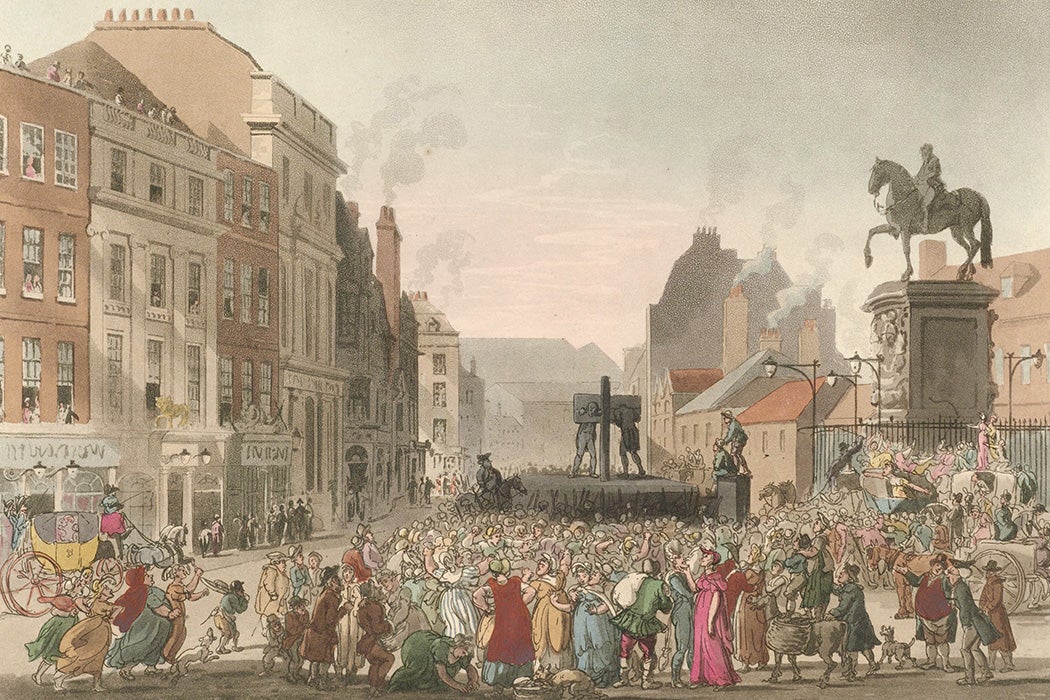The Luddite rebellions of early nineteenth century England have since given their name to those opposed to technology. It’s debatable if the Luddites were ever luddites: they weren’t opposed to new technology per se, they were opposed to the devaluation of their own labor and the attack on their livelihoods by the introduction of new machines. They were machine-breakers because the machines were the easiest targets in what historian Eric Hobsbawm characterized as “collective bargaining by riot.”
Taking their name from the apocryphal Ned Ludd, an apprentice who supposedly smashed stocking-making frames a generation or two earlier, these rebellious textile workers and their allies were most active in northern England between 1811 and 1813. These were met with the brute force of English law, but only after initial trials were judged “insufficient to instill enough terror to quell the rebellion,” writes historian Geoffrey Poitras.
“No charges were made at the Luddite trials for capital offenses directly relevant to the revolutionary acts of treason and sedition,” he notes. “Rather, the trials involved many standard felony charges that risked capital penalties, such as burglary, robbery, arson, and ‘endeavouring by threat’ to obstruct justice.”
Poitras examines the suppression of this labor militancy in the special Luddite trials of 1812 and 1813. The twice-yearly Assizes, local sittings of courts for major crimes, proved to be too lenient for national authorities, so special trial commissions were set up in Lancaster, Chester, and York.
The records of these trials were well preserved, writes Poitras. At the Lancaster Special Assizes, held in May and June of 1812, four people were hung for setting fire to weaving mills with power looms; three were hung for Riot and Burglary; one (a woman) was hung for Riot, Larceny, and Grand Larceny; six others were transported for seven-year terms. At the Chester Special Commission trials of May 1812, five were sentenced to death; eight were transported for seven-year terms; eleven others had their death sentences commuted to transport for life. At the York Special Commission of January 1813, seventeen were sentenced to be hung; six were transported for seven-year terms; and one had his death sentence commuted to transport for life.
At the beginning of the nineteenth century, there were more than 220 capital offenses on the English law books. Grand larceny, punishable by death, was for instance defined as the theft of goods worth more than 12 pence, about equivalent of £3.5 today. Many of these were for crimes against property; there has rarely been such an overt illustration of criminal justice as the servant of the class who writes the laws. (Up to the modest electoral reforms of 1832, a mere 4,500 men in Britain could vote in Parliamentary elections in a country of 2.6 million. The 1918 law that famously gave women the vote in the UK also did away with the last restrictions on male suffrage.)
A confusing, overlapping series of statutes, including the Riot Act, Unlawful Oaths Act, Criminal Law Act of 1782, the Malicious Injury Act, and Malicious Shooting or Stabbing Act were added to by a burst of anti-Luddite panic law-making in 1812, Poitras writes. Five laws were introduced to deal specifically with the disturbances, including two Preservation of the Peace Acts and a Destruction of Stocking Frames, etc. Act, also known as the Frame-Breaking Act. The latter made the destruction of mechanized looms a capital felony. George Gordon Bryon made his debut speech in the House of Lords unsuccessfully arguing against this act, Poitras notes, defending the Luddites as “meager with famine, sullen with despair.”
This reign of legal terror would eventually be called the Bloody Code. It began to be undone with 1823’s Judgement of Death Act, which made the death penalty discretionary for most crimes. (The last execution in the UK took place in 1964.)
Weekly Newsletter
In practice, juries and even magistrates under the Bloody Code could show mercy against what many, not just the accused, thought extreme justice, Poitras explains. In grand larceny cases, for instance, juries were known to undervalue the amount of goods stolen—to save the accused from death or penal transportation. And, in fact, the earliest trials of the Luddites in the regular Assizes, were rather remarkably not bloody. For instance, at the Nottingham Lent Assize of March 1812, eighteen Luddites were brought to trial. No death penalties resulted; transportation for life was the harshest penalty meted out, and there were numerous acquittals.
With its special commissions, the state would make sure that there would be much less mercy shown for the next round of Luddites brought to trial. Luddite crime was construed as a radical assault on property. Those fighting for their livelihoods would forfeit their lives. Luddism, as historian E. P. Thompson put it in his classic The Making of the English Working Class, “ended on the scaffold.”







